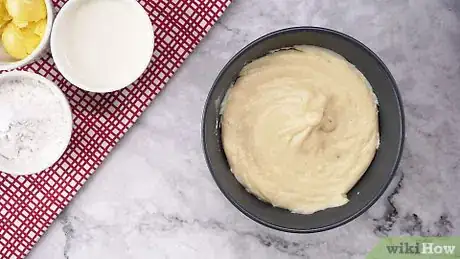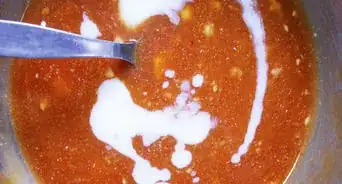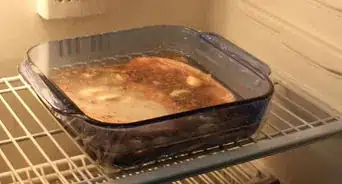This article was co-authored by wikiHow Staff. Our trained team of editors and researchers validate articles for accuracy and comprehensiveness. wikiHow's Content Management Team carefully monitors the work from our editorial staff to ensure that each article is backed by trusted research and meets our high quality standards.
The wikiHow Culinary Team also followed the article's instructions and verified that they work.
This article has been viewed 867,701 times.
Learn more...
White sauce (also known by its French name, béchamel)[1] is a simple but versatile sauce that's often one of the very first recipes taught to aspiring chefs. On its own, it's a fine addition to a variety of dishes like chicken and vegetables – but it's also the basis for many other more complex recipes like alfredo sauce and soufflés. Get started on your own creamy, delicious white sauce today with Step 1 below!
- Prep time: 5 minutes
- Cook time: 10 minutes
- Total time: 15 minutes
Ingredients
For Basic Béchamel White Sauce:
- 2 Tablespoons butter
- 3 Tablespoons flour
- 1 Cup milk (optionally heated)
- 1/4 Teaspoon salt
- Dash white pepper
For Alfredo Pasta Sauce:
- 2 Tablespoons butter
- 2 Tablespoons olive oil
- 2 Garlic cloves (minced)
- 1 Cup heavy cream
- 1/4 Teaspoon white pepper
- 1/4 Cup cooking cream cheese
- 1/2 Cup parmesan cheese (grated)
- 1/4 Cup asiago cheese (grated)
- Dry white wine
Steps
Basic Béchamel White Sauce
-
1Melt butter (any type works). In a heavy-bottomed saucepan, melt your butter over low-to-medium heat on the stove. When the butter's fully melted, proceed immediately to the next step without allowing it to reduce any further.[2]
-
2Whisk in flour, salt and pepper. In a separate bowl, roughly combine flour, salt, and pepper. Whisk this mixture into the melted butter, combining until smooth and paste-like.Advertisement
-
3Cook until bubbly. Heat over medium heat until the mixture bubbles without letting it brown - about 1 minute. This is mixture of fat and flour is called a roux and can be used as a base or thickening ingredient in a variety of recipes including gumbo and other thick soups.
-
4Heat milk (optional). It's not essential to heat your milk before adding it to your white sauce, but doing so can help ensure your end product is silky smooth. If you'd like to do this, heat your milk in a separate pan over low heat just until small bubbles form around the edges, then remove from heat.
-
5Add milk slowly. Stir your milk into your roux mixture. For smoothness, it's best to add a little milk, stir until fully incorporated into the sauce, then repeat. If you add all the milk at once, it may not incorporate fully, leaving you with an uneven, lumpy sauce.[3]
-
6Whisk until smooth. When you've added all your milk, use a whisk to gently stir your sauce, making sure to break up any remaining solid portions. Stir until your sauce is even throughout.
-
7Cook until thickened and smooth. All that's left to do is to cook your sauce until it reduces to your desired thickness and taste. Cook for about 2-3 minutes more, frequently stirring and sampling your sauce to ensure evenness.[4] If needed, feel free to add additional salt and pepper to taste. Serves about 4.
- When cooled, this sauce can develop an unappetizing skin. To avoid this, cover it with wax paper or pour a thin layer of milk on top before putting it in the fridge.
-
8Try customizing your sauce. One of the most useful properties of basic white sauces is that they're so easy to modify for a wide range of purposes. For instance, if you'd like to give your sauce an added "kick", try adding red pepper. You might also try grating cheddar cheese into your sauce for scrumptious cheesy flavor. Experiment - because its flavor is so neutral, most common ingredients complement a basic white sauce well.
- Case in point - the recipe in the next section modifies the basic white sauce with a few extra ingredients and the omission of flour to create a delicious Alfredo pasta sauce.
Alfredo Pasta Sauce
-
1Melt butter with olive oil. Add your butter and olive oil to a heavy-bottomed saucepan. Heat over low-to-medium heat until the butter is fully melted but hasn't begun to smoke or brown.
-
2Add garlic, cream, and pepper. Add your minced garlic and heavy cream to the saucepan and stir until well-mixed.[5] Add pepper (to taste) and heat to a low simmer. Stir often.
-
3Add cheeses. Add your cream cheese, parmesan, and asiago. Stir to incorporate, making sure that all cheeses have completely melted before proceeding.
- This step affords you a great deal of freedom - feel free to fine-tune your mixture of cheeses to find one that better suits your taste. Some chefs, for example, like to substitute mozzarella or add a dash of sharp white cheddar for added flavor.
-
4Add wine to taste. Add just a dash of your dry white wine to your sauce, then stir to incorporate. After the wine has been absorbed, sample your sauce. Depending on how you like the flavor, you may want to add more wine to your sauce as you see fit. Keep in mind that adding a great deal of wine will give you a somewhat watery sauce, meaning you'll have to allow it to reduce for longer.
- You can use grape powder or grape juice in place of wine. It has almost the same effect.
-
5Reduce over low simmer. If it isn't still simmering, bring your sauce up to a low simmer, then allow it to gradually reduce, stirring frequently. Frequent stirring is essential - since it will be relatively thick, Alfredo sauce is susceptible to sticking and burning. You want your end product to be thick, creamy, and flavorful without being gummy or solid. When you've reached a good thickness, immediately remove your sauce from heat and serve with pasta. Serves 4-6.
-
6Finished.
Community Q&A
-
QuestionHow can I make a simple pasta for kids?
 Community AnswerIf you're using sauce, pick a simple one like marinara. If you want your kids to eat it, then buy the fun shaped mac and cheese boxes and just use the pasta, not the cheese. Boil it in water just as you would do with pasta, and boom! It will really get kids to want to eat it.
Community AnswerIf you're using sauce, pick a simple one like marinara. If you want your kids to eat it, then buy the fun shaped mac and cheese boxes and just use the pasta, not the cheese. Boil it in water just as you would do with pasta, and boom! It will really get kids to want to eat it. -
QuestionShould I use salt with the milk when I am making white sauce, and if so, why?
 Community AnswerAdding salt only adds to the sauce's flavor. It is optional.
Community AnswerAdding salt only adds to the sauce's flavor. It is optional. -
QuestionWhat can I use if I do not have a whisk?
 Community AnswerStir with two forks, one atop the other as they'd be stacked in a drawer, to provide a sufficient amount of air when blending.
Community AnswerStir with two forks, one atop the other as they'd be stacked in a drawer, to provide a sufficient amount of air when blending.
References
- ↑ https://www.epicurious.com/recipes/food/views/white-sauce-or-bechamel-sauce-40046
- ↑ https://www.seriouseats.com/recipes/2016/09/bechamel-white-sauce-recipe.html
- ↑ https://www.foodnetwork.com/recipes/bechamel-sauce-recipe-1956748
- ↑ https://www.allrecipes.com/recipe/139987/basic-bechamel-sauce/
- ↑ https://www.allrecipes.com/recipe/22831/alfredo-sauce/
About This Article
To make a basic white sauce, first melt 2 tablespoons (30 grams) of butter in a saucepan over medium heat. Then, add 2 tablespoons (16 grams) of all-purpose flour, and whisk until the mixture is smooth. Pour in 1 cup (235 milliliters) of milk and keep whisking until the sauce thickens. Finally, add a bit of salt and a dash of white pepper. To make a cheesy white sauce, add ½ cup (60 grams) of grated cheese to the saucepan after you add the milk. For tips on how to make a white Alfredo sauce for pasta, read on!



























































